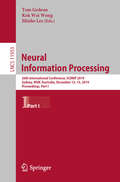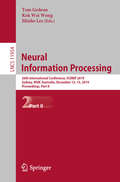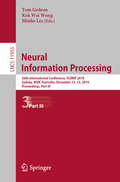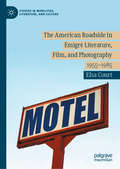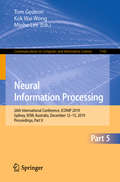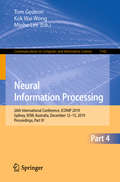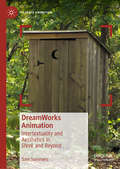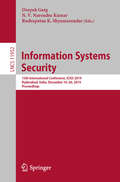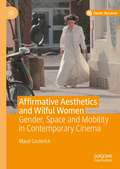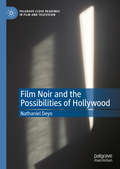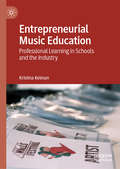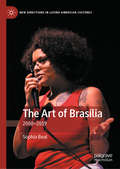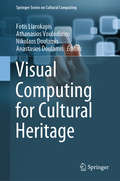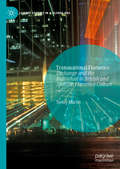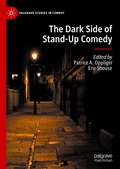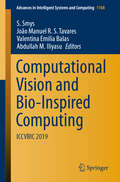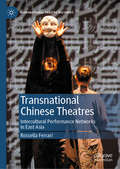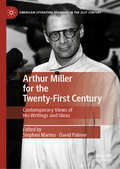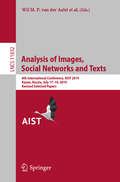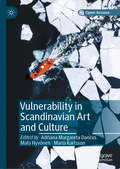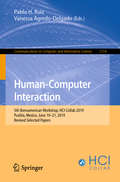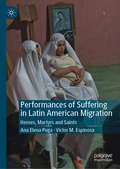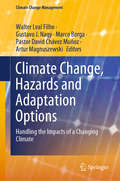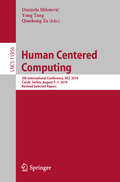- Table View
- List View
Neural Information Processing: 26th International Conference, ICONIP 2019, Sydney, NSW, Australia, December 12–15, 2019, Proceedings, Part I (Lecture Notes in Computer Science #11953)
by Minho Lee Kok Wai Wong Tom GedeonThe three-volume set of LNCS 11953, 11954, and 11955 constitutes the proceedings of the 26th International Conference on Neural Information Processing, ICONIP 2019, held in Sydney, Australia, in December 2019. The 173 full papers presented were carefully reviewed and selected from 645 submissions. The papers address the emerging topics of theoretical research, empirical studies, and applications of neural information processing techniques across different domains. The first volume, LNCS 11953, is organized in topical sections on adversarial networks and learning; convolutional neural networks; deep neural networks; feature learning and representation; human centred computing; human centred computing and medicine; hybrid models; and artificial intelligence and cybersecurity.
Neural Information Processing: 26th International Conference, ICONIP 2019, Sydney, NSW, Australia, December 12–15, 2019, Proceedings, Part II (Lecture Notes in Computer Science #11954)
by Minho Lee Kok Wai Wong Tom GedeonThe three-volume set of LNCS 11953, 11954, and 11955 constitutes the proceedings of the 26th International Conference on Neural Information Processing, ICONIP 2019, held in Sydney, Australia, in December 2019.The 173 full papers presented were carefully reviewed and selected from 645 submissions. The papers address the emerging topics of theoretical research, empirical studies, and applications of neural information processing techniques across different domains. The second volume, LNCS 11954, is organized in topical sections on image processing by neural techniques; learning from incomplete data; model compression and optimisation; neural learning models; neural network applications; and social network computing.
Neural Information Processing: 26th International Conference, ICONIP 2019, Sydney, NSW, Australia, December 12–15, 2019, Proceedings, Part III (Lecture Notes in Computer Science #11955)
by Minho Lee Kok Wai Wong Tom GedeonThe three-volume set of LNCS 11953, 11954, and 11955 constitutes the proceedings of the 26th International Conference on Neural Information Processing, ICONIP 2019, held in Sydney, Australia, in December 2019.The 173 full papers presented were carefully reviewed and selected from 645 submissions. The papers address the emerging topics of theoretical research, empirical studies, and applications of neural information processing techniques across different domains. The third volume, LNCS 11955, is organized in topical sections on semantic and graph based approaches; spiking neuron and related models; text computing using neural techniques; time-series and related models; and unsupervised neural models.
The American Roadside in Émigré Literature, Film, and Photography: 1955–1985 (Studies in Mobilities, Literature, and Culture)
by Elsa CourtThe American Roadside in Émigré Literature, Film, and Photography: 1955–1985 traces the origin of a postmodern iconography of mobile consumption equating roadside America with an authentic experience of the United States through the postwar road narrative, a narrative which, Elsa Court argues, has been shaped by and through white male émigré narratives of the American road, in both literature and visual culture. While stressing that these narratives are limited in their understanding of the processes of exclusion and unequal flux in experiences of modern automobility, the book works through four case studies in the American works of European-born authors Vladimir Nabokov, Robert Frank, Alfred Hitchcock, and Wim Wenders to unveil an early phenomenology of the postwar American highway, one that anticipates the works of late-twentieth-century spatial theorists Jean Baudrillard, Michel Foucault, and Marc Augé and sketches a postmodern aesthetic of western mobility and consumption that has become synonymous with contemporary America.
Neural Information Processing: 26th International Conference, ICONIP 2019, Sydney, NSW, Australia, December 12–15, 2019, Proceedings, Part V (Communications in Computer and Information Science #1143)
by Minho Lee Kok Wai Wong Tom GedeonThe two-volume set CCIS 1142 and 1143 constitutes thoroughly refereed contributions presented at the 26th International Conference on Neural Information Processing, ICONIP 2019, held in Sydney, Australia, in December 2019.For ICONIP 2019 a total of 345 papers was carefully reviewed and selected for publication out of 645 submissions. The 168 papers included in this volume set were organized in topical sections as follows: adversarial networks and learning; convolutional neural networks; deep neural networks; embeddings and feature fusion; human centred computing; human centred computing and medicine; human centred computing for emotion; hybrid models; image processing by neural techniques; learning from incomplete data; model compression and optimization; neural network applications; neural network models; semantic and graph based approaches; social network computing; spiking neuron and related models; text computing using neural techniques; time-series and related models; and unsupervised neural models.
Neural Information Processing: 26th International Conference, ICONIP 2019, Sydney, NSW, Australia, December 12–15, 2019, Proceedings, Part IV (Communications in Computer and Information Science #1142)
by Minho Lee Kok Wai Wong Tom GedeonThe two-volume set CCIS 1142 and 1143 constitutes thoroughly refereed contributions presented at the 26th International Conference on Neural Information Processing, ICONIP 2019, held in Sydney, Australia, in December 2019.For ICONIP 2019 a total of 345 papers was carefully reviewed and selected for publication out of 645 submissions. The 168 papers included in this volume set were organized in topical sections as follows: adversarial networks and learning; convolutional neural networks; deep neural networks; embeddings and feature fusion; human centred computing; human centred computing and medicine; human centred computing for emotion; hybrid models; image processing by neural techniques; learning from incomplete data; model compression and optimization; neural network applications; neural network models; semantic and graph based approaches; social network computing; spiking neuron and related models; text computing using neural techniques; time-series and related models; and unsupervised neural models.
DreamWorks Animation: Intertextuality and Aesthetics in Shrek and Beyond (Palgrave Animation)
by Sam SummersDreamWorks is one of the biggest names in modern computer-animation: a studio whose commercial success and impact on the medium rivals that of Pixar, and yet has received far less critical attention.The book will historicise DreamWorks’ contribution to feature animation, while presenting a critical history of the form in the new millennium. It will look beyond the films’ visual aesthetics to assess DreamWorks’ influence on the narrative and tonal qualities which have come to define contemporary animated features, including their use of comedy, genre, music, stars, and intertextuality. It makes original interventions in the fields of film and animation studies by discussing each of these techniques in a uniquely animated context, with case studies from Shrek, Antz, Kung Fu Panda, Madagascar, Shark Tale, Bee Movie, Trolls and many others. It also looks at the unusual online afterlife of these films, and the ways in which they have been reappropriated and remixed by subversive online communities.
Loss and the Literary Culture of Shakespeare’s Time (Early Modern Literature in History)
by Matthew Steggle Roslyn L. Knutson David McInnisAs early modernists with an interest in the literary culture of Shakespeare’s time, we work in a field that contains many significant losses: of texts, of contextual information, of other forms of cultural activity. No account of early modern literary culture is complete without acknowledgment of these lacunae, and although lost drama has become a topic of increasing interest in Shakespeare studies, it is important to recognize that loss is not restricted to play-texts alone. Loss and the Literary Culture of Shakespeare’s Time broadens the scope of the scholarly conversation about loss beyond drama and beyond London. It aims to develop further models and techniques for thinking about lost plays, but also of other kinds of lost early modern works, and even lost persons associated with literary and theatrical circles. Chapters examine textual corruption, oral preservation, quantitative analysis, translation, and experiments in “verbatim theater”, plus much more.
Information Systems Security: 15th International Conference, ICISS 2019, Hyderabad, India, December 16–20, 2019, Proceedings (Lecture Notes in Computer Science #11952)
by Rudrapatna K. Shyamasundar Deepak Garg N. V. Narendra KumarThis book constitutes the proceedings of the 15th International Conference on Information Systems Security, ICISS 2019, held in Hyderabad, India, in December 2019.The 13 revised full papers and 4 short papers presented in this book together with 4 abstracts of invited talks were carefully reviewed and selected from 63 submissions.The papers cover topics such as: smart contracts; formal techniques; access control; machine learning; distributed systems; cryptography; online social networks; images and cryptography.
Affirmative Aesthetics and Wilful Women: Gender, Space and Mobility in Contemporary Cinema
by Maud CeuterickFifty years of feminist thought have made the idea that women stay at home while men dominate the streets seem outdated; nevertheless, Ceuterick argues that theoretical considerations of gender, space, and power in film theory remain limited by binary models. Looking instead to more fluid models of spatial relations inspired by Sara Ahmed, Rosi Braidotti, and Doreen Massey, this book discovers wilful, affirmative, and imaginative activations of gender on screen. Through close, micro-analysis of historic European Messidor (Alain Tanner, 1979) and contemporary world cinema: Vendredi Soir (Claire Denis, 2002), Wadjda (Haifaa Al-Mansour, 2012), and Head-On (Fatih Akin, 2004), this book identifies affirmative aesthetics: light, texture, rhythm, movement and sound, all of which that participate in a rewriting of bodies and spaces. Ultimately, Ceuterick argues, affirmative aesthetics can challenge the gender categories and power structures that have been thought to determine our habitation of cars, homes, and city streets. Wilful women drive this book forward, through their movement and stillness, imagination and desire, performance and abjection.
Film Noir and the Possibilities of Hollywood (Palgrave Close Readings in Film and Television)
by Nathaniel DeyoBuilt around close readings of 11 noir films, this book seeks to refresh our understanding of “film noir” by returning to the films themselves. Pushing against totalizing or generalizing approaches, which may have the unintended effect of flattening out significant distinctions and differences between individual approaches, Film Noir and the Possibilities of Hollywood argues for the importance of staying attuned the varied and variegated formal, aesthetic and thematic strategies at work in individual films. By focusing on these strategies, the book invites readers to consider anew the enabling possibilities of Hollywood filmmaking in the studio era.
Entrepreneurial Music Education: Professional Learning in Schools and the Industry
by Kristina KelmanThis book addresses the gap between formal music education curricula and the knowledge and skills necessary to enter the professional music industry. It uses extensive data from a long-running research project where high school students were invited to start their own business venture, Youth Music Industries. Not only did this act as a business venture, but it also functioned as a learning environment informed by the concepts of Communities of Practice and social capital. Exploring how entrepreneurial qualities were developed, their learning was subsequently captured and distilled into a set of design principles: in this way, a pedagogical approach was developed that can be transferred across the creative industries more broadly. This book will be of interest and value to scholars of music education, as well as those preparing students for the creative industries.
The Art of Brasília: 2000-2019 (New Directions in Latino American Cultures)
by Sophia BealPeople from outside of Brasília often dismiss Brazil’s capital as socially divided, boring, corrupt, and emotionally cold. Apparently its founders created not a vibrant capital, but a cultural wasteland. However, as Sophia Beal argues, Brasília’s contemporary artists are out to prove the skeptics wrong. These twenty-first-century artists are changing how people think about the city and animating its public spaces. They are recasting Brasília as a vibrant city of the arts in which cultural production affirms a creative right to the city. Various genres—prose, poetry, film, cultural journalism, music, photography, graffiti, street theater, and street dance—play a part. Brasília’s initial 1960s art was state-sanctioned, carried out mainly by privileged, white men. In contrast, the capital’s contemporary art is marked by its diversity, challenging norms about who has a voice within the Brasília art scene. This art demystifies the capital’s inequities and imagines alternative ways of inhabiting the city.
Visual Computing for Cultural Heritage (Springer Series on Cultural Computing)
by Anastasios Doulamis Fotis Liarokapis Athanasios Voulodimos Nikolaos DoulamisThis book provides insights into the state of the art of digital cultural heritage using computer graphics, image processing, computer vision, visualization and reconstruction, virtual and augmented reality and serious games. It aims at covering the emergent approaches for digitization and preservation of Cultural Heritage, both in its tangible and intangible facets. Advancements in Digital Cultural Heritage research have been abundant in recent years covering a wide assortment of topics, ranging from visual data acquisition, pre-processing, classification, analysis and synthesis, 3D modelling and reconstruction, semantics and symbolic representation, metadata description, repository and archiving, to new forms of interactive and personalized presentation, visualization and immersive experience provision via advanced computer graphics, interactive virtual and augmented environments, serious games and digital storytelling. Different aspects pertaining to visual computing with regard to tangible (books, images, paintings, manuscripts, uniforms, maps, artefacts, archaeological sites, monuments) and intangible (e.g. dance and performing arts, folklore, theatrical performances) cultural heritage preservation, documentation, protection and promotion are covered, including rendering and procedural modelling of cultural heritage assets, keyword spotting in old documents, drone mapping and airborne photogrammetry, underwater recording and reconstruction, gamification, visitor engagement, animated storytelling, analysis of choreographic patterns, and many more. The book brings together and targets researchers from the domains of computing, engineering, archaeology and the arts, and aims at underscoring the potential for cross-fertilization and collaboration among these communities.
Transnational Flamenco: Exchange and the Individual in British and Spanish Flamenco Culture (Leisure Studies in a Global Era)
by Tenley MartinThis book provides insight into how flamenco travels, the forms it assumes in new locales, and the reciprocal effects on the original scene. Utilising a postnational approach to cultural identity, Martin explores the role of non-native culture brokers in cultural transmission. This concept, referred to as ‘cosmopolitan human hubs’, builds on Kiwan and Meinhof’s ‘hubs’ theory of network migration to move cultural migration and globalisation studies forwards. Martin outlines a post-globalisation flamenco culture through analysis of ethnographic research carried out in the UK, Sevilla and Madrid. Insight into these glocal scenes characterises flamenco as a historically globalized art complex, represented in various hubs around the world. This alternative approach to music migration and globalisation studies will be of interest to students and scholars across leisure studies, musicology, sociology and anthropology.
The Dark Side of Stand-Up Comedy (Palgrave Studies in Comedy)
by Patrice A. Oppliger Eric ShouseThis book focuses on the “dark side” of stand-up comedy, initially inspired by speculations surrounding the death of comedian Robin Williams. Contributors, those who study humor as well as those who perform comedy, join together to contemplate the paradoxical relationship between tragedy and comedy and expose over-generalizations about comic performers’ troubled childhoods, addictions, and mental illnesses. The book is divided into two sections. First, scholars from a variety of disciplines explore comedians’ onstage performances, their offstage lives, and the relationship between the two. The second half of the book focuses on amateur and lesser-known professional comedians who reveal the struggles they face as they attempt to hone successful comedy acts and likable comic personae. The goal of this collection is to move beyond the hackneyed stereotype of the sad clown in order to reveal how stand-up comedy can transform both personal and collective tragedies by providing catharsis through humor.
Computational Vision and Bio-Inspired Computing: ICCVBIC 2019 (Advances in Intelligent Systems and Computing #1108)
by João Manuel R. S. Tavares Valentina Emilia Balas S. Smys Abdullah M. IliyasuThis proceedings book presents state-of-the-art research innovations in computational vision and bio-inspired techniques. Due to the rapid advances in the emerging information, communication and computing technologies, the Internet of Things, cloud and edge computing, and artificial intelligence play a significant role in the computational vision context. In recent years, computational vision has contributed to enhancing the methods of controlling the operations in biological systems, like ant colony optimization, neural networks, and immune systems. Moreover, the ability of computational vision to process a large number of data streams by implementing new computing paradigms has been demonstrated in numerous studies incorporating computational techniques in the emerging bio-inspired models. The book reveals the theoretical and practical aspects of bio-inspired computing techniques, like machine learning, sensor-based models, evolutionary optimization, and big data modeling and management, that make use of effectual computing processes in the bio-inspired systems. As such it contributes to the novel research that focuses on developing bio-inspired computing solutions for various domains, such as human–computer interaction, image processing, sensor-based single processing, recommender systems, and facial recognition, which play an indispensable part in smart agriculture, smart city, biomedical and business intelligence applications.
Transnational Chinese Theatres: Intercultural Performance Networks in East Asia (Transnational Theatre Histories)
by Rossella FerrariThis is the first systematic study of networks of performance collaboration in the contemporary Chinese-speaking world and of their interactions with the artistic communities of the wider East Asian region. It investigates the aesthetics and politics of collaboration to propose a new transnational model for the analysis of Sinophone theatre cultures and to foreground the mobility and relationality of intercultural performance in East Asia. The research draws on extensive fieldwork, interviews with practitioners, and direct observation of performances, rehearsals, and festivals in Asia and Europe. It offers provocative close readings and discourse analysis of an extensive corpus of hitherto untapped sources, including unreleased video materials and unpublished scripts, production notes, and archival documentation.
Arthur Miller for the Twenty-First Century: Contemporary Views of His Writings and Ideas (American Literature Readings in the 21st Century)
by Stephen Marino David PalmerArthur Miller for the Twenty-First Century: Contemporary Views of His Writings and Ideas brings together both established Miller experts and emerging commentators to investigate the sources of his ongoing resonance with audiences and his place in world theatre. The collection begins by exploring Miller in the context of 20th-century American drama. Chapters discuss Miller and Eugene O’Neill, Tennessee Williams, Edward Albee, David Mamet, and Sam Shepard, as well as thematic relationships between Miller’s ideas and the explosion of significant women and African American dramatists since the 1970s. Other essays focus more directly on interpretations of Miller’s individual works, not only plays but also essays and fiction, including a discussion of Death of a Salesman in China. The volume concludes by considering Miller and current cultural issues: his work for human rights, his depiction of American ideals of masculinity, and his anticipation of contemporary posthumanism.
Analysis of Images, Social Networks and Texts: 8th International Conference, AIST 2019, Kazan, Russia, July 17–19, 2019, Revised Selected Papers (Lecture Notes in Computer Science #11832)
by Vladimir Batagelj Panos M. Pardalos Andrey V. Savchenko Dmitry I. Ignatov Wil M. P. van der Aalst Marcello Pelillo Michael Khachay Natalia Loukachevitch Sergei O. Kuznetsov Irina A. Lomazova Amedeo Napoli Valentina Kuskova Andrey Kutuzov Elena TutubalinaThis book constitutes the post-conference proceedings of the 8th International Conference on Analysis of Images, Social Networks and Texts, AIST 2019, held in Kazan, Russia, in July 2019. The 27 full and 8 short papers were carefully reviewed and selected from 134 submissions (of which 21 papers were automatically rejected without being reviewed). The papers are organized in topical sections on general topics of data analysis; natural language processing; social network analysis; analysis of images and video; optimization problems on graphs and network structures; and analysis of dynamic behavior through event data.
Vulnerability in Scandinavian Art and Culture
by Mats Hyvönen Adriana Margareta Dancus Maria KarlssonIn this open access book, seventeen scholars discuss how contemporary Scandinavian art and media have become important arenas to articulate and stage various forms of vulnerability in the Scandinavian welfare states. How do discourses of privilege and vulnerability coexist and interact in Scandinavia? How do the Scandinavian countries respond to vulnerability given increased migration? How is vulnerability distributed in terms of margin and centre, normality and deviance? And how can vulnerability be used to move audiences towards each other and accomplish change? We address these questions in an interdisciplinary study that brings examples from celebrated and provocative fiction and documentary films, TV-series, reality TV, art installations, design, literature, graphic art, radio podcasts and campaigns on social media.
Human-Computer Interaction: 5th Iberoamerican Workshop, HCI-Collab 2019, Puebla, Mexico, June 19–21, 2019, Revised Selected Papers (Communications in Computer and Information Science #1114)
by Vanessa Agredo-Delgado Pablo H. RuizThis book constitutes the proceedings of the 5th Iberoamerican Workshop on Human-Computer Interaction, HCI-Collab 2019, held in Puebla, Mexico, in June 2019.The 31 full papers presented in this volume were carefully reviewed and selected from 55 submissions. The papers describe models, design patterns, implementations, evaluations of existing applications, and systemic reviews; all of which are very important aspects within HCI.
Performances of Suffering in Latin American Migration: Heroes, Martyrs and Saints
by Ana Elena Puga Víctor M. EspinosaThis book questions the reliance on melodrama and spectacle in social performances and cultural productions by and about migrants from Mexico and Central America to the United States. Focusing on archetypal characters with nineteenth-century roots that recur in the twentieth- and twenty-first centuries – heroic saviors, saintly mothers and struggling fathers, martyred children and rebellious youth – it shows how theater practitioners, filmmakers, visual artists, advocates, activists, journalists, and others who want to help migrants often create migrant melodramas, performances that depict their heroes as virtuous victims at the mercy of evil villains. In order to gain respect for the human rights that are supposedly already theirs on paper and participate in a global market that trades in performances of suffering, migrants themselves sometimes accept the roles into which they are cast, or even cast themselves. Some express their suffering publicly, often on demand. Others find ways to twist, parody, resist, or reject migrant melodrama.
Climate Change, Hazards and Adaptation Options: Handling the Impacts of a Changing Climate (Climate Change Management)
by Walter Leal Filho Gustavo J. Nagy Marco Borga Pastor David Chávez Muñoz Artur MagnuszewskiThis book addresses the issue of climate change risks and hazards holistically. Climate change adaptation aims at managing climate risks and hazards to an acceptable level, taking advantage of any positive opportunities that may arise. At the same time, developing suitable responses to hazards for communities and users of climate services is important in ensuring the success of adaptation measures. But despite this, knowledge about adaptation options, including possible actions that can be implemented to improve adaptation and reduce the impacts of climate change hazards, is still limited. Addressing this need, the book presents studies and research findings and offers a catalogue of potential adaptation options that can be explored. It also includes case studies providing illustrative and inspiring examples of how we can adapt to a changing climate.
Human Centered Computing: 5th International Conference, HCC 2019, Čačak, Serbia, August 5–7, 2019, Revised Selected Papers (Lecture Notes in Computer Science #11956)
by Qiaohong Zu Yong Tang Danijela MiloševićThis book constitutes thoroughly reviewed, revised and selected papers from the 5th International Conference on Human Centered Computing, HCC 2019, held in Čačak, Serbia, in August 2019. The 48 full and 23 short papers presented in this volume were carefully reviewed and selected from a total of 133 submissions. The papers focus on deep learning and its applications on a variety of real-life problems, ranging from image/video analysis, to human-computer interaction, and to logistics and supply chain management.
